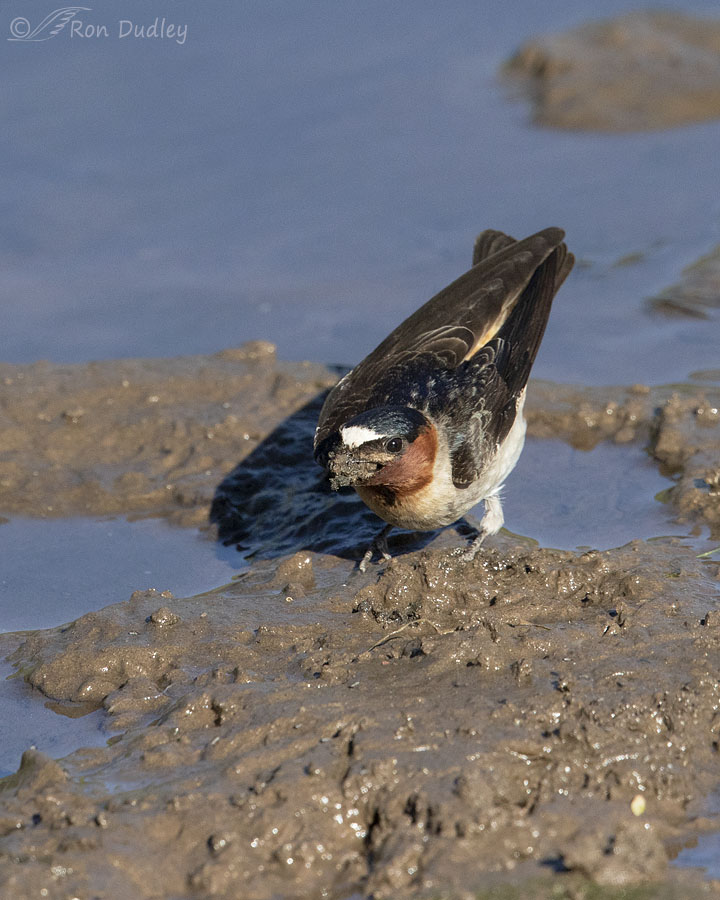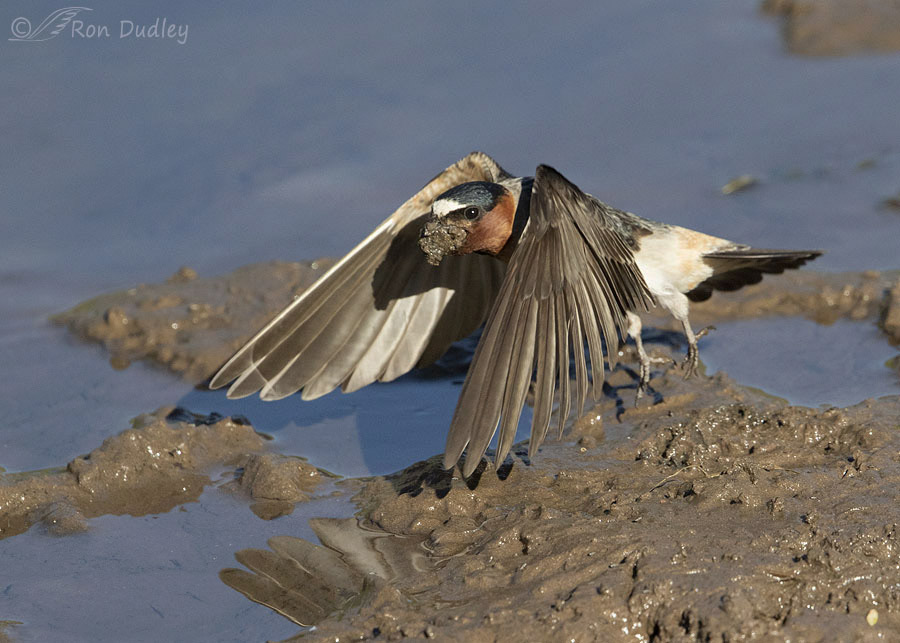A common species that I find difficult to get an uncommonly good photo of.

1/3200, f/6.3, ISO 800, Canon 7D Mark II, Canon EF 500mm f/4L IS II USM + EF 1.4 III Extender, not baited, set up or called in
Two days ago Cliff Swallows were busy gathering mud for nest building from a stream edge in the Wasatch Mountains. They’re a scrappy bunch – vicious fights often broke out during the mud-gathering process for reasons that seem unclear to me but I won’t be posting any fighting photos today.
This bird had been stuffing its bill with mud until it seemed like it could hold no more and my intention was to get a quality takeoff or flight shot when it lifted off. I’d already tried and failed many times but I’m nothing if I’m not stubborn so I wasn’t about to give up. I’m glad I didn’t.
The only reason I’m including this photo is to provide context for the following one. I’ve cropped it vertically to exclude another swallow just out of frame to the right.

1/4000, f/6.3, ISO 800, Canon 7D Mark II, Canon EF 500mm f/4L IS II USM + EF 1.4 III Extender, not baited, set up or called in
After stuffing one more bit of mud into its already overstuffed bill the swallow took off and this resulting photo is one I like very much.
Most of the bird is sharp, the light is good, the takeoff posture appeals to me and I have eye contact including a catch light. The shadow of his head and mud load on his right wing is an excellent background for the mud in his bill – if the background had been mud on the ground or his well-lit wing the mud in his bill wouldn’t have shown up nearly as well.
And then there’s a little thing that for some reason I like a lot – we can see the reflection of four of his right wing primaries in the water below and in front of the left wing.
Sometimes the little things make a big positive difference and for me that reflection is an example. But don’t ask me to explain why…
Ron
Notes:
- Cliff Swallows were one of the first North American birds to be described. I find it interesting that they were first mentioned in the literature when Spaniard Silvestre Velez de Escalante encountered large numbers of them in Utah’s Wasatch Range in 1776. In that year Escalante passed through appropriately named Spanish Fork Canyon which as the crow flies is only about 38 miles south of the Wasatch canyon where I photographed this swallow.
- The average Cliff Swallow nest is constructed of 900-1200 mud daubs or pellets and the nest may be more than a mile from the mud source. Can you imagine the work involved with making that many round trips before the nest is finished. And then they typically have four hungry chicks to raise and keep fed. Exhausts me just to think about it.


I know that this is about yesterdays Cliff Swallows, but I could not believe that no one mentioned the wing tips picking up mud like little dairy queen swirls. Really neat.
Ron, we’ve had cliff swallows gathering mud from the gutter across the street from us in San Bernardino. I’m working at home, and they give me a great break from work. I’ve enjoyed watching their habits, and I’m using the things I’ve learned from you as I photograph them, and then cull the photos. I don’t have one to compare with your shots, but I’m making progress.
I appreciate you letting the teacher come out as you discuss your photos. Thank you!
What a kind comment, Bob. And thanks for putting up with, even appreciating, the teacher in me – an impulse that I can’t seem to put behind me.
Ron, as a teacher myself, I see the patterns as you critique your photos. Almost as if you had a rubric. Seeing the consistency in your critiques is what caught my attention, and as the saying goes, “We are our own worst critics.”
I wonder how much a load of mud weighs and what percent that is of a swallow’s body weight?
I really like Everett’s comment “…but that was not a law he was interested in.”
So true these days.
Dave, I don’t know about the weight of the mud by the swallow only weighs .74 oz so I’ll bet it’s significant compared to the bird’s weight. Wet mud like this stuff is relatively heavy.
They’re both wonderful shots! I find myself drawn to the first one (maybe it’s the vertical crop ). I think that the slight “downward dog” position of the bird combined with a 3/4 head-on view is what I find so appealing.
). I think that the slight “downward dog” position of the bird combined with a 3/4 head-on view is what I find so appealing.
I can’t imagine traveling 1200 miles to build a home. Nature blows my mind once again!
“I can’t imagine traveling 1200 miles to build a home”
Especially one you’ll only use for a few weeks. Then the next year you have to do it all over again. Thanks, Marty.
Had to Google cliff swallow nests to see where the mud ends up. And, I might have missed the reflection of the wings, too, if you hadn’t pointed it out. Nice!
Cathy, I’ll have to take some nest photos for next time I post about them. I know a spot where there’s hundreds of them but they’re not very accessible or close. Thanks.
That is an impressive beakful. Assuming it all makes it back to the nest, I’d estimate less than 50 round trips would do it unless there’s a Swallow mansion in process. I guess I always assumed it was a combination of mud and saliva to cement the nest. Their soil analysis abilities are a wonder.
So, you’re just driving down the road and see the muddy bank and think “I’ll bet some Swallows show up here”? Your ability to observe these things is uncanny.
Lyle, that’s a spot where I photograph lots of birds, including kingfishers, so I’m there often looking for birds. They’re pretty easy to spot along the creek bank while they’re gathering mud.
There’s up to 1200 “mouthfuls” or mud daubs in each nest. Each takes a round trip. Say the nest is a half mile away from the mud source – that’s 1200 round trips of a mile each adding up to 1200 miles of flying while carrying a load for 600 of those miles.
That is a huge load. You would think it would have an inpact on the swallow’s centre of gravity but if it does the determined little builder compensates very very well.
Thanks Ron. Which I type so often here that my lazy self is considering creating a short-cut key for those words.
I type it a lot too, EC. Let me know if you find that shortcut…
Very nice photos, that is a lot of mud. One of my simple pleasures was watching the barn swallows build their nest while Haley was horseback ridding at an indoor ring.
Thanks, April.
The simple pleasures mean more than ever these days. It’s a damn good thing we have our birds!
Another set of great pics! And educational too. I love swallows of all types and have never managed to get a good pic of any. Unless they are perched on man-made items such as nesting boxes – so it’s nice that you have managed such a great photo in a natural setting.
Thanks, Joanne. No question, they like man made perches.
Thank you for these, Ron! What a strong and courageous builder for its children. Deep appreciation for things I’d never glimpse without your photos. Mary
Thank you, Mary.
WOW Ron! I’ve never before seen just how much mud that cliff swallows can and will carry in one flight! Good heavens! What a load! It’s a wonder they can get off the ground.
I spent hours delighting in the flights of zooming swallows feeding in Oregon and then again their diligent nest-building activities at a race at Laguna Seca Raceway in California. I was supposed to be watching race cars, but oh well. The birds were far more interesting to me, despite that I couldn’t see the details of their nest-building activities since they were building underneath the windows of the press room.
As for the whys of what appeals to you and what doesn’t, well, that’s just the magical mystery of your artistry. And what a special gift it is! Thank you for sharing it every day.
Laura, I understand your fascination with swallows. As a young kid on the MT farm I used to spend many hours watching them up close as they constructed their nests on the side of a barn (and inside it too) and then raised their youngsters.
Interesting post in more ways than one. Do they need a ‘special mud’…I would think mud is mud but then I don’t know. I’ve not seen one of this particular variety but I was recently watching barn swallows do the same thing! Each years I watch a flock at the same curve in a road going through one of the marshes gathering mud. They never go to any other spots…same curve mud hole…is that learned as it’s really not a distance thing but fascinating to watch and I’m sure they are not the same birds year after year. More questions the more you observe.
“Do they need a ‘special mud’?”
Kathy, Cornell’s Birds of the World has this to say on the subject:
“Birds apparently assess mud composition. In Montana, nests were composed of 61.4% sand particles, 25.7% silt particles, and 12.7% clay There is little organic material in mud; grass is not mixed into mud, as in Barn Swallow nests. In Quebec, Cliff Swallows were presented with mud of differing adhesive properties (densities of clay and silt particles); birds chose the mud that adhered best.”
Interesting – obviously they do have to be picky or it wouldn’t hold! Sometimes it doesn’t – just never thought about it
Effing Norton (probably again) had my computer done with an error windows is, in theory, working on…
Nature is truly amazing. Taking that mud for hundreds of trips to build their homes is remarkable. A delight to watch unless they are building at your house. I once lived next door to an MLB pitcher whose name shall not be disclosed who was power hosing them off the side of his house as fast as they could build. I told him it was against the law to knock them down, but that was not a law he was interested in. Watching what they can do to a house I grudgingly would have to agree. That second photo is beautiful and I would have missed the wing reflection had you not mentioned it.
Thank you, Everett. A major league pitcher who lived in Arizona married a shirt-tail relative of mine but they were eventually divorced. Can’t remember his name at the moment but his first wife’s first name was Cheryl.
Ron, How wonderful to see just how the cliff swallow works. I remember seeing them for the first time in the South Dakota Badlands…and appreciate yournarrative that established context and even provides historical information.
Elizabeth
Good! Thanks, Elizabeth.